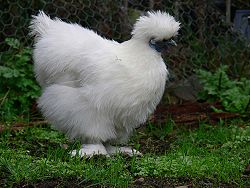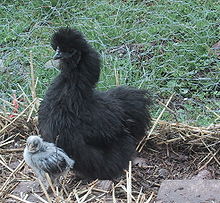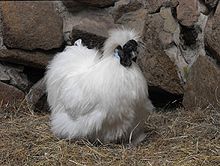- Silkie
-
This article is about a variety of chicken. For other uses, see Silkie (disambiguation).
Silkie 
A White Silkie hen, non-beardedOther names Silky Country of origin China Classification APA Asiatic ABA Feather Legged Traits Skin Color Black Egg Color Cream Comb Type Walnut Chicken (Gallus gallus domesticus) The Silkie (sometimes incorrectly spelled Silky) is a breed of chicken named for its atypically fluffy plumage, which is said to feel like silk. The breed has several other unusual qualities, such as dark blue flesh and bones, blue earlobes, and five toes on each foot (most chickens only have four). They are often exhibited in poultry shows, and come in several colors (red, buff, blue, black, white, and partridge).
In addition to their distinctive physical characteristics, Silkies are well known for their calm, friendly temperament. Among the most docile of poultry, Silkies are considered an ideal pet. Hens are also exceptionally broody, and make good mothers. Though they are fair layers themselves, laying about three eggs a week, they are commonly used to hatch eggs from other breeds and bird species.
Silkies most likely originated in China, but Southeast Asia is also sometimes proposed. The first western account of the breed comes from Marco Polo, who mentioned chickens with fur-like plumage in his Asian travelogues in the 13th century. The Renaissance author Ulisse Aldrovandi also spoke of chickens akin to Silkies. Today, the breed is recognized for exhibition, and is fairly common in the poultry world.
Contents
History
It is unknown exactly where or when fowl with their singular combination of attributes first appeared, but the most well documented point of origin is China. Other places in Southeast Asia have been named as possibilities, such as India and Java.[1] The earliest surviving written account of Silkies comes from Marco Polo, who wrote of a furry chicken in the 13th century, during his travels in Asia.[2] In 1599, Ulisse Aldrovandi, a writer and naturalist at the University of Bologna, Italy, published a comprehensive treatise on chickens which is still read and admired today. In it, he spoke on "wool-bearing chickens" and ones "clothed with hair like that of a black cat".[3]
Silkies most likely made their way to the West via the Silk Route and maritime trade. The breed was recognized officially in the North America via acceptance in to the Standard of Perfection in 1874 (the first year of publication).[1] Once Silkies became more common in the West, many myths were perpetuated about them. Early Dutch breeders told buyers they were the offspring of chickens and rabbits,[4] while sideshows promoted them as having actual mammalian fur.[5]
In the 21st century, Silkies are one of the most popular and ubiquitous ornamental breeds of chicken. They are often kept as ornamental or pet chickens by backyard keepers and in zoos, and are also often used to incubate and raise the offspring of other poultry (including waterfowl like ducks and geese) and game birds such as quail and pheasants.[1]
Characteristics
Silkies are often mistakenly called a bantam breed, and although some countries do consider them a bantam, this varies according to region and many breed standards class them officially as large fowl. The bantam Silkie is actually a separate variety, which is a well-tempered miniature version of a standard Silkie, with no defining characteristics besides smaller size. Almost all North American strains of the breed are bantam sized, but in Europe the large is the original version. However, even "large" Silkies are relatively small chickens, with standard bantam size males weighing only four pounds (1.8 kilos), and females weigh three pounds (1.36 kilos).[4] The American Standard of Perfection calls for males that are 36 ounces (1 kilo), and females that are 32 ounces (910 grams).[6]
Silkie plumage is unique among chicken breeds; Silkie-like feathering may appear as a recessive mutation in individuals of other varieties, but no other true breed has it. It has been compared to silk,[7] and to fur. Their feathers lack functioning barbicels, and are thus similar to down on other birds and leave Silkies unable to fly. The overall result is a soft, fluffy appearance.[8]
Silkies appear in two distinct varieties: Bearded and Non-bearded. Bearded Silkies have an extra muff of feathers under the beak area that covers the earlobes. They also are separated according to color. Colors of Silkie recognized for competitive showing include Black, Blue, Buff, Gray, Partridge, Splash and White. Alternative hues, such as Cuckoo, Red, and Lavender, also exist. All Silkies have a small Walnut-type comb, dark wattles, and turquoise blue earlobes. In addition these defining characteristics, Silkies have five toes on each foot. Other breeds which exhibit this rare trait include the Dorking, Faverolles, and Sultan.[4]
All Silkies have black skin, bones and grayish-black meat; their Chinese language name is wu gu ji (烏骨雞,[9] literally "dark boned chicken"), meaning "black-boned chicken".[7] Melanism which extends beyond the skin into an animal's connective tissue is a rare trait, and the Silkie is one of only a handful of chickens to exhibit it. Disregarding color, the breed does not generally produce as much as the more common meat breeds of chicken.[8]
Silkies lay a fair number of cream-colored eggs, but production is often interrupted due to their extreme tendency to go broody; a hen will produce 100 eggs in an ideal year. Their capacity for incubation, which has been selectively bred out of most egg-laying fowl, is often exploited by poultry keepers by allowing Silkies to raise the offspring of other birds. In addition to being good mothers, Silkies are universally renowned for their calm, friendly temperament. They do well in confinement, and interact very well with children. This docility can cause Silkies to be bullied by more active or aggressive birds when kept in mixed flocks.[10]
In cuisine
The black meat of a Silkie is generally considered an unusual or unpalatable attribute in European and American cuisines.[7] In contrast, several Asian cuisines consider Silkie meat a gourmet food. Chinese cuisine especially values the breed, but it is also a common ingredient in some Japanese, Cambodian, Vietnamese and Korean dishes. Areas where Chinese cuisine has been a strong influence, such as Malaysia, may also cook Silkie. As early as the 7th century, traditional Chinese medicine has held that chicken soup made with Silkie meat is a curative food.[7] The usual methods of cooking include using Silkie to make broth, braising, and in curries. Traditional Chinese soup made with Silkie also uses ingredients such as wolfberries, Dioscorea opposita (white yam), orange peel, and fresh ginger.[11] A few fusion restaurants in metropolitan areas of the West have also cooked it as a part of traditional American or French cuisine, such as in confit.[7] It was featured on the third season of Bravo's Top Chef during the elimination challenge on the first episode.
See also
- Kadaknath, another black meat breed
Footnotes
- ^ a b c (Ekarius 2007, p. 158)
- ^ (Graham 2006, p. 130)
- ^ (Smith & Daniel 1975, p. 49)
- ^ a b c (Graham 2006, p. 130)
- ^ (Percy 2002, p. 37)[Full citation needed]
- ^ (Ekarius 2007, p. 159)
- ^ a b c d e (Louie 2007)
- ^ a b (Ekarius 2007, pp. 158–159)
- ^ Dunlop, Fuchsia (2003). Land of Plenty. W. W. Norton & Company. pp. 236,372. ISBN 0-393-05177-3.
- ^ (Graham 2006, p. 131)
- ^ "Recipe: Black-Skinned Chicken Soup". The New York Times. January 17, 2007. http://www.nytimes.com/2007/01/17/dining/174rex.html?_r=1&oref=slogin. Retrieved 2008-06-23.
References
- Ekarius, Carol (2007). Storey's Illustrated Guide to Poultry Breeds. 210 MAS MoCA Way, North Adams MA 01247: Storey Publishing. ISBN 978-1-58017-667-5.
- Graham, Chris (2006). Choosing and Keeping Chickens. 2-4 Heron Quays London E14 4JP: Octopus Publishing. ISBN 9780793806010.
- Louie, Elaine (January 17, 2007). "Now, a Chicken in Black". The New York Times. http://www.nytimes.com/2007/01/17/dining/17blac.html?ref=dining. Retrieved 2008-06-23.
- Smith, Page; Daniel, Charles (1975). The Chicken Book. Little, Brown & Company. ISBN 0316801578.
Further reading
- Heinrichs, Christine (2007). How To Raise Chickens. Voyageur Press. ISBN 9780793806010.
- Staples, Tamara (2001). The Fairest Fowl. 85 Second St. San Francisco, CA 94105: Chronicle Books. ISBN 081183137X.
- Verhoff, Esther (2003). The Complete Encyclopedia of Chickens. Lisse, Netherlands: Rebo International. ISBN 9789036615921.
- Faraco, Cloris D.; Vaz, SA; Pástor, MV; Erickson, CA (2001). "Hyperpigmentation in the Silkie fowl correlates with abnormal migration of fate-restricted melanoblasts and loss of environmental barrier molecules". Developmental Dynamics 220 (3): 212–225. doi:10.1002/1097-0177(20010301)220:3<212::AID-DVDY1105>3.0.CO;2-9. PMID 11241830. http://www3.interscience.wiley.com/journal/77004101/abstract?CRETRY=1&SRETRY=0.
External links
Categories:- Chicken breeds
- Chicken breeds originating in China
Wikimedia Foundation. 2010.



